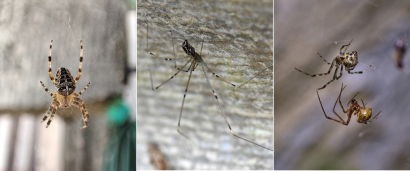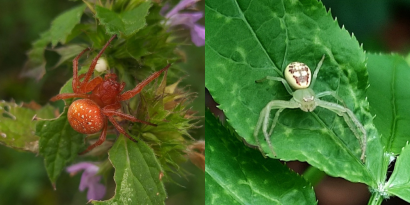What kind of spiders live in Hungarian gardens? And what does this tell researchers and garden lovers?
The first year of the citizen-science study investigating spider species and biodiversity has ended
The Research Institute of Organic Agriculture (ÖMKi) assessed the spider population of Hungarian gardens from spring to autumn last year with the involvement of volunteer researchers: as part of the study, called Pók-Háló or ‘Spider Web’, hundreds of garden registrations and thousands of photographs were received from all over the country. The task of the volunteer researchers was to take photographs of our eight-legged friends. Few people know the different species of spiders, and many are even a little afraid of them, even though they are excellent indicators of the state of a habitat: a large number of spider species indicates a high level of biodiversity. There are more than 800 species of spiders in our country, and dozens of species can be present even in a single garden. ÖMKi specialists presented the first results of the programme last week at the SEEN (Social Engagement in Ecology Network) Hungary 2024 citizen science conference. The large number of different spider species found in gardens exceeded all the researchers’ expectations. The study was carried out within the framework of a social responsibility programme which last week was awarded a special prize by the jury at the fourth DoingGood – CSR Award.
Although citizen science is a relatively new concept in Hungary, based on a few leading domestic examples and international practice, it is clear that there is enormous added value in establishing connections between researchers and volunteers when it comes to interesting scientific investigations. This is also why ÖMKi announced two community-based studies last year, including the Spider Web citizen science programme on the topic of biodiversity.
In addition to plants, our gardens are also home to many other living creatures, and our gardening habits shape the biological diversity of our immediate environment. The Spider Web study explored this topic with the help of volunteer participants, based on the observation that spiders are excellent indicators of the state of a habitat: the large number of spider species suggests a high level of biodiversity.
The aim of the unusual project involving volunteer “researchers” was to demonstrate through spiders how much impact our gardening habits and the “degree of naturalness” of our garden have on the living communities that develop there. A garden where we preserve the elements of natural vegetation and plant various flowering plants provides a habitat for many other living creatures, thus contributing to the creation of a more valuable and sustainable environment from the point of view of nature conservation.
From May to late autumn, amateur photographers were on the look-out
From the beginning of May to the end of October 2023, volunteers had the opportunity to register their garden and upload their observations in the form of photographs on the online interface created on the ÖMKi website. First, registrants filled out a questionnaire about their garden, then photographs of spiders observed in the garden could be uploaded to the registered garden at any time during the data-collection period. The ÖMKi team continuously processed the data received, specialists reviewed the photographs taken of the spiders, identifying the observed specimens and recording the collected data in map-based databases.
The number of spider photos received exceeded the researchers’ expectations
The project was very popular, which meant that when the project ended the researchers had more data than expected. 214 participants registered a total of 223 gardens from 184 different locations around Hungary. Based on this, we can say that observations came from almost large class of Hungarian landscape.
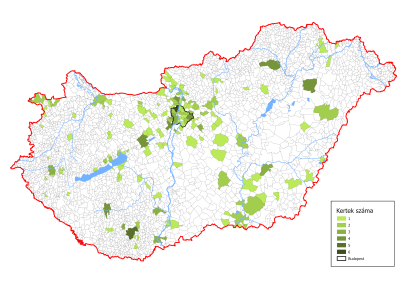
The geographical location of the gardens registered in the Spider Web project: The 223 gardens from which data on spiders was supplied cover 184 different locations.
A total of 3,330 photos from the 223 gardens were uploaded to the project’s online interface. After thorough examination, classification and verification of the images, the researchers obtained 2800 individual units of data suitable for evaluation, which means that in 2800 cases they were able to identify the spider in the image, at least at the family level. Based on the number of images received, from the registered gardens they managed to detect a total of 127 spider species from 29 families.
Let’s take a look at the first results!
Information about the most frequently occurring spiders identified in the Spider Web participatory study is available on the ÖMKi website. Among the discovered species and groups, we can find well-known spiders (e.g. varieties of the European garden spider) as well as spiders that may be less well-known to the hobby gardener (e.g. the marbled cellar spider or the American house spider). The researchers also prepared interesting species presentations for the most common species.
After summarizing the data, we can say that orb-weaving spiders (Araneidae) dominated in the participating gardens: representatives of this family accounted for 18.6% of all observations. After orb-weavers, the next most common families were wolf spiders (Lycosidae – 13.9%), “daddy-long-legs” type spiders (Pholcidae – 11.9%), funnel weavers (Agelenidae – 11.1%), tangle-web spiders (Theridiidae – 11%), crab spiders (Thomisidae – 6.4%) and jumping spiders (Salticidae – 4.6%).
Especially rare and interesting species have also been found in domestic gardens. Examples include the strawberry spider (Araneus alsine), which is especially common near wetlands (e.g. bogs), or Diaea livens, a species of crab spider which is primarily associated with oak forests.
The initial hypothesis of the researchers in the study was that any human intervention or gardening habits that reduce the number of plant species in the garden and the structural diversity of the garden will ultimately have a negative impact on the composition and biodiversity of the arthropod communities that develop there, including spiders. Therefore, during the garden registration, the participants were asked several questions related to their gardens and gardening habits.
Flower gardens and paved surfaces
Researchers examined the effect of the proportion of natural/semi-natural habitat within the garden on their species richness. To do so, they compared the data provided by the garden owner with the relative (spider) species richness of the gardens, and found that there is a significant negative correlation between species richness and the proportion of artificial ground-cover. This essentially means that as the proportion of paved surface increases, the species richness of the garden decreases. Obviously, the larger the area occupied by buildings, paved terraces, paths, etc. in the garden, the less natural/semi-natural living space remains for living creatures, and the more uniform the garden’s spider population will be. In general, with the increase in the size of the living space, structural diversity also tends to increase, thus favouring biodiversity all the more.
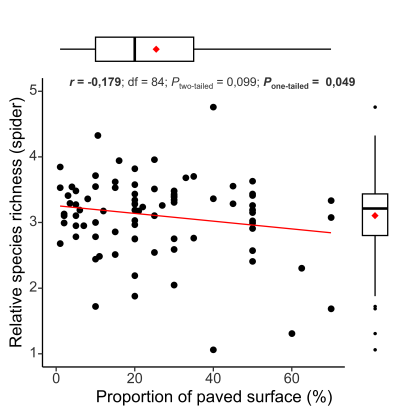
The relative species richness of spiders is negatively affected by an increase in the proportion of paved surface in the garden. The red line indicates the linear relationship between the two variables.
This study also confirmed the correlation whereby the more built-up and covered surface our garden contains, the more the quality of the garden as a habitat decreases, as does its structural diversity. If we want to favour the natural communities that develop in the garden, we should leave natural or semi-natural areas with as large and diverse a structure as possible, then keep a look out for those remarkable little creatures, spiders!
Chemical use vs. biodiversity
Based on our preliminary results, it also appears that, for instance, based on the frequency of the use of chemical plant protection agents (pesticides – including herbicides, insecticides and fungicides), the “degree of naturalness” of the garden can be broadly assessed, and the findings seem to support the researchers’ hypothesis that the use of chemicals (once or multiple times per year) results in a decrease in the number of spider species compared to gardens that do not use chemicals, meaning that the use of pesticides has a negative effect on the biodiversity of gardens.
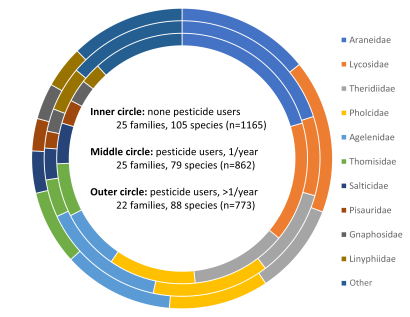
Effect of pesticide use on the composition of spider communities in gardens. The figure shows the relative proportions of the 10 most common spider families in gardens where pesticides are not used (inner circle); used once a year (middle circle); used several times a year (outer circle).
While there is not a great difference in the number of species of spiders observed between the group who apply chemicals once a year and those who apply them multiple times per year (79 and 88 species), the relative proportions of spider families within the spider community do show a marked difference. The use of chemicals and their extent are often combined with other gardening practices: for example, those who like a “strictly regimented” garden are typically more inclined to apply chemicals as well. Frequent mowing of the undergrowth and grass can also have an adverse effect on the composition of a garden’s spider population and biodiversity. At the same time, it is difficult to separate the effects of individual factors, such as the frequency of mowing the lawn or the use of chemicals, and the researchers will further try to separate and evaluate the effects of individual factors in a more detailed analysis of the data.
